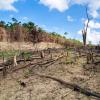
Deforestation continues to be one of the greatest challenges in the fight against biodiversity loss and climate change. Countries all over the world have instituted protected areas, but there is still mounting human pressure on many of these areas. A new study looks at tropical deforestation and the key factors driving it.
As global climate deadlines approach, the need to ramp up conservation efforts that are truly enforced is more important than ever. Deforestation is one of the greatest challenges when it comes to global greenhouse gas emissions and it must be reduced if we are to reach any temperature goals. Although there are protected areas worldwide in significant areas like the tropics, one-third of these protected areas are under immense human pressure, generally due to subsistence farming and shifts in agriculture and pastures, poor forest management, and industrial farming for cash crops like oil palm.
A recent IIASA study published in the journal Frontiers in Conservation Science takes a new approach from previous studies by for the first time using a crowdsourced dataset of drivers of deforestation to quantify the drivers of deforestation in protected areas by continent. The approach involved gathering data on deforestation drivers using crowdsourcing and Geo-Wiki to obtain 150K random sample locations within the subtropical to tropical latitudes, which were then used to generate a spatially explicit map of the drivers.
“Without the help of the crowd, it would not be possible to gather this amount of high-quality data on the drivers of tropical deforestation,” explains IIASA researcher Linda See, a coauthor on the paper.
This new data set represents a more up-to-date and higher resolution version of that produced in previous studies, which gives a clear overview of the drivers of deforestation on a global scale. When compared to other spatially explicit map approaches, this study represents a major improvement by providing a higher spatial resolution and adding additional layers of data (e.g., shifting cultivation and other subsistence agriculture) to allow for greater differentiation between driver types.
“Our results corroborate previous findings in the literature, such as that overall deforestation rates in protected areas in Latin America and Africa are lower than total deforestation. This confirms that protected areas are helping to some degree to curb deforestation. We however also found that protected areas are less effective at curbing deforestation in Asia,” notes IIASA Strategic Initiatives Program Director, Steffen Fritz, who led the study.
The study shows that the main drivers of deforestation in the tropics of Latin America are pasture and shifting cultivation, which matches the effects of traditional cattle ranching found in Brazil and other parts of South and Central America, but also more recent shifts to smaller scale agriculture. Africa is still very much dominated by subsistence agriculture and shifting cultivation as observed in the Congo Basin. There is also some evidence of managed forests, wildfires, roads, and commercial agriculture, confirming a trend towards selective logging and industrial agriculture. Similarly, Asia is dominated by shifting cultivation and other subsistence agriculture, commercial oil palm, and managed forests, all of which have been identified as drivers of deforestation.
The study highlights the efforts needed for more effective management of protected areas in the tropics from large-scale human activity, such as policy change and advanced monitoring systems. Results from this study also highlight that a lot of deforestation is occurring in protected national parks, which can be important for future policymaking.
“The research from this study sheds light on the underlying drivers of deforestation on a continental level allowing for a better understanding regarding the effectiveness of protected areas as well as the underlying drivers of deforestation,” Fritz concludes.
References:
Fritz, S., Laso Bayas, J.C., See, L., Schepaschenko, D., Hofhansl, F., Jung, M., Dürauer, M., Georgieva, I., Danylo, O., Lesiv, M., and McCallum, I. (2022) A Continental Assessment of the Drivers of Tropical Deforestation With a Focus on Protected Areas. Frontiers in Conservation Science 3:830248. DOI: 10.3389/fcosc.2022.830248 [pure.iiasa.ac.at/17796]
News

11 March 2025
IIASA provides insights on research, technology, and innovation to Austrian federal states

06 March 2025
IIASA’s CAT Research Group joined the UN ECOSOC Partnership Forum 2025’s event: Global Challenges Action Innovation, Emerging Technologies & the Power of Partnerships

14 February 2025


